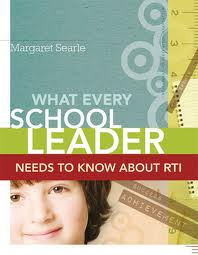Leadership for RTI
What Every School Leader Needs to Know about RTI
by Margaret Searle
(ASCD, 2010 – Learn more)
What Every School Leader Needs to Know about RTI by Margaret Searle is a book that demystifies the confusion about RTI (Response to Intervention) and provides the steps and framework necessary to seamlessly apply the RTI approach within our schools. The book focuses on using a problem solving approach that can help ALL students who are struggling academically and behaviorally.
According to Searle, RTI isn’t a program you can purchase, and she cautions educators that we can no longer support the “wait to fail” mindset for our struggling students. The three tiers of intervention that Searle outlines are proven to increase success for general, gifted, and struggling students who are not reaching their potential. Her anecdotal stories, case studies, and research-based information provide concrete examples of evidenced-based interventions in schools where she was a coach to administrators and teachers.
A Pyramid of Interventions

Searle instructs the reader on how to set up assessments, analyze data and use the three-tier intervention system to optimize results. Her research-based guide makes you realize the importance of note taking, setting detailed agendas, and using “quality data analysis to guide discussions and decisions for improvement.” She stresses the important role of leaders in setting the agenda and promoting honest conversations to help keep staff on task while implementing the RTI program.
In addition, Searle stresses the importance of establishing parental involvement through the use of a database of strategies. These family-friendly strategies can be applied by parents to target specific skills; they’re essentially stress-free and promote partnerships between teacher and parent. The analogy Searle presents to the reader for RTI to be functional is a stool with three legs. The three legs are (1) the assessment process; (2) a tiered intervention menu, and (3) a problems-solving process.
I would carry this analogy further to represent what is needed for students to succeed. One leg is the teachers to provide the information and guides. The second leg is the student who works and applies the information. The third leg is the parent who supports and encourages their children to do their best. All three legs must all work together in order for the student to be successful.
A leadership perspective
Written with school leaders and administrators in mind, Searle’s text includes strategies to “get teachers on board” and to assure skeptical minds that the RTI research-based concept must be in place for our students to all receive the quality educational program they deserve. She answers the questions of how to start, what RTI looks like when it is done well, and how school leaders can get parents as well as teachers involved.
The author eases the reader’s mind by reassuring administrators that quality educational strategies such as Professional Learning Communities, differentiated instruction, summative and formative assessment, and curriculum mapping are all part of an effective RTI framework. The book guides administrators in setting up efficient school based teams and infrastructure to sustain and support RTI.
What Every School Leader Needs to Know about RTI is an important book for all school-based and district-level administrators to read.
Linda Biondi is a fifth grade teacher at Pond Road Middle School in Robbinsville, New Jersey. She has written for Education World, the Responsive Classroom newsletter, and the ERIC Clearinghouse. She’s also the recipient of several grants that promote inquiry and a literacy enriched curriculum, and a consultant with the National Writing Project.





































1 Response
[…] Read the review […]